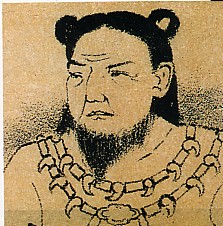Emperor Kōshō
Emperor Kōshō (孝昭天皇, Kōshō-tennō) was the 5th emperor of Japan,[3] according to the traditional order of succession.[4] Historians consider Emperor Kōshō to be a legendary person,[5] and the name Kōshō-tennō was created for him posthumously by later generations.
| Kōshō | |
|---|---|
| Emperor of Japan | |
 | |
| 475 BC – 393 BC (traditional)[1] | |
| Predecessor | Itoku |
| Successor | Kōan |
| Born | 501 BC[2] |
| Died | 393 BC (aged 108) |
| Burial | Wakigami no Hakata no yama no e no misasagi (Nara) |
No certain dates can be assigned to this emperor's life or reign.[6] The conventionally accepted names and sequence of the early emperors were not to be confirmed as "traditional" until the reign of Emperor Kammu, who was the 50th monarch of the Yamato dynasty.[7]
The Gukanshō records that Kōshō ruled from the palace of Ikekokoro-no-miya at Waki-no-kami in what will come to be known as Yamato province.[8]
Traditional history
Kōshō is almost certainly a legend. The Kojiki records only his name and genealogy. The Nihonshoki includes Kōshō as the fourth of "eight undocumented monarchs" (欠史八代,, Kesshi-hachidai).[9]
Emperor Kōshō was the oldest son of Emperor Itoku.[10] Jinnō Shōtōki records that his mother was Amanotoyototsu-hime, and his grandmother by his mother's side was Okishimimi-no-kami.[11]
Events of Kōshō's life
The absence of information about Kōshō does not show that he was not real. Very little information is available for study before the rule of the 29th monarch, Emperor Kimmei (509?-571).[12]
After his death
This emperor's official name after his death (his posthumous name) was regularized many centuries after the lifetime which was ascribed to Kōshō.[13]
The actual site of his grave is not known. According to the Imperial Household Agency, this emperor is venerated at a memorial Shinto shrine (misasagi) at Nara.[3]
Emperor Kōshō Media
Japanese Imperial kamon — a stylized chrysanthemum blossom
Related pages
References
- ↑ "Genealogy of the Emperors of Japan" (PDF). Kunaicho.go.jp. Retrieved May 8, 2019.
- ↑ Kenneth Henshall (2013). Historical Dictionary of Japan to 1945. Scarecrow Press. p. 487. ISBN 9780810878723.
- ↑ 3.0 3.1 Imperial Household Agency (Kunaichō), 孝昭天皇 (5); retrieved 2011-10-19.
- ↑ Titsingh, Isaac. (1834). Annales des empereurs du japon, pp. 4-5Brown, Delmer et al. (1979). Gukanshō, p. 251; Varley, Paul. (1980). Jinnō Shōtōki, p. 90; Nussbaum, Louis-Frédéric et al. (2002). "Traditional order of Tennō" in Japan encyclopedia, pp. 962-963.
- ↑ Kelly, Charles F. "Kofun Culture," Japanese Archaeology. April 27, 2009; retrieved 2011-10-19.
- ↑ Ponsonby-Fane, Richard. (1959). The Imperial House of Japan, p. 30.
- ↑ Aston, William George. (1896). Nihongi, pp. 109.
- ↑ Brown, p. 251; Varley, p. 90.
- ↑ Aston, pp. 142-143.
- ↑ Ponsonby-Fane, p. 30; Varley, p. 90.
- ↑ Varley, p. 90.
- ↑ Titsingh, pp. 34-36; Brown, pp. 261-262; Varley, pp. 123-124.
- ↑ Aston, pp. 144-145.
| Preceded by Emperor Itoku |
Legendary Emperor of Japan Kōshō 475-393 BC (traditional dates) |
Succeeded by Emperor Kōan |

